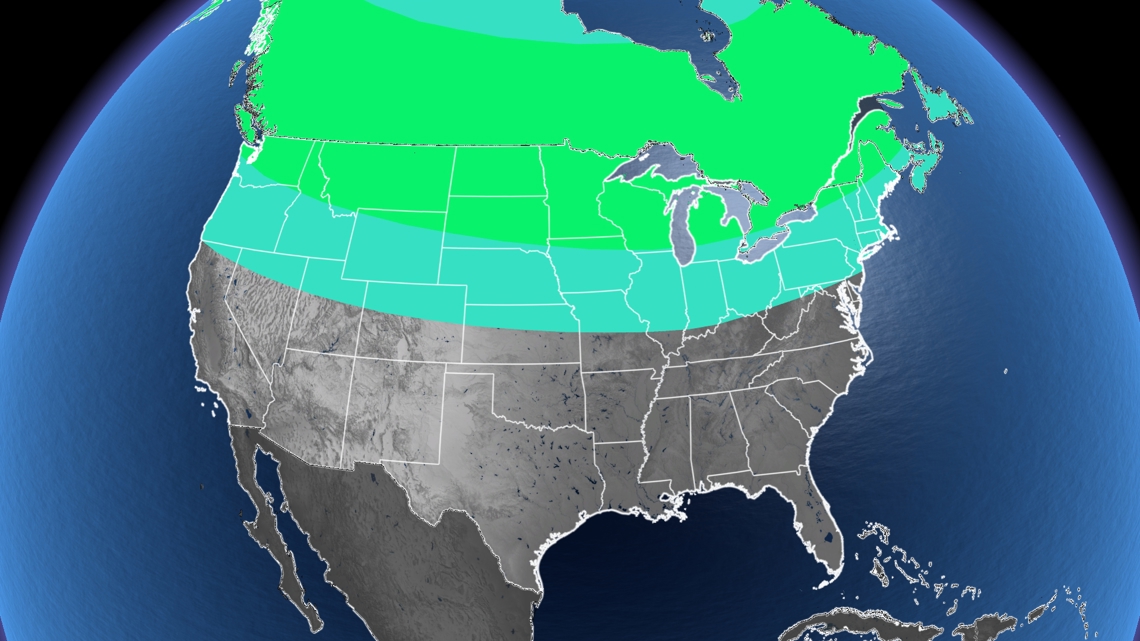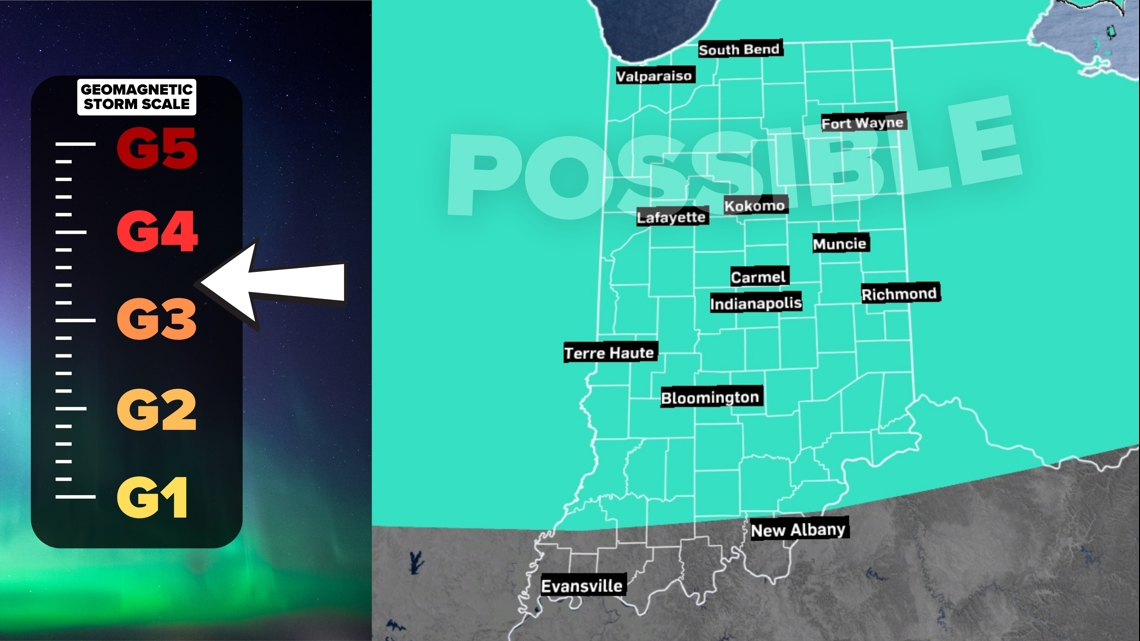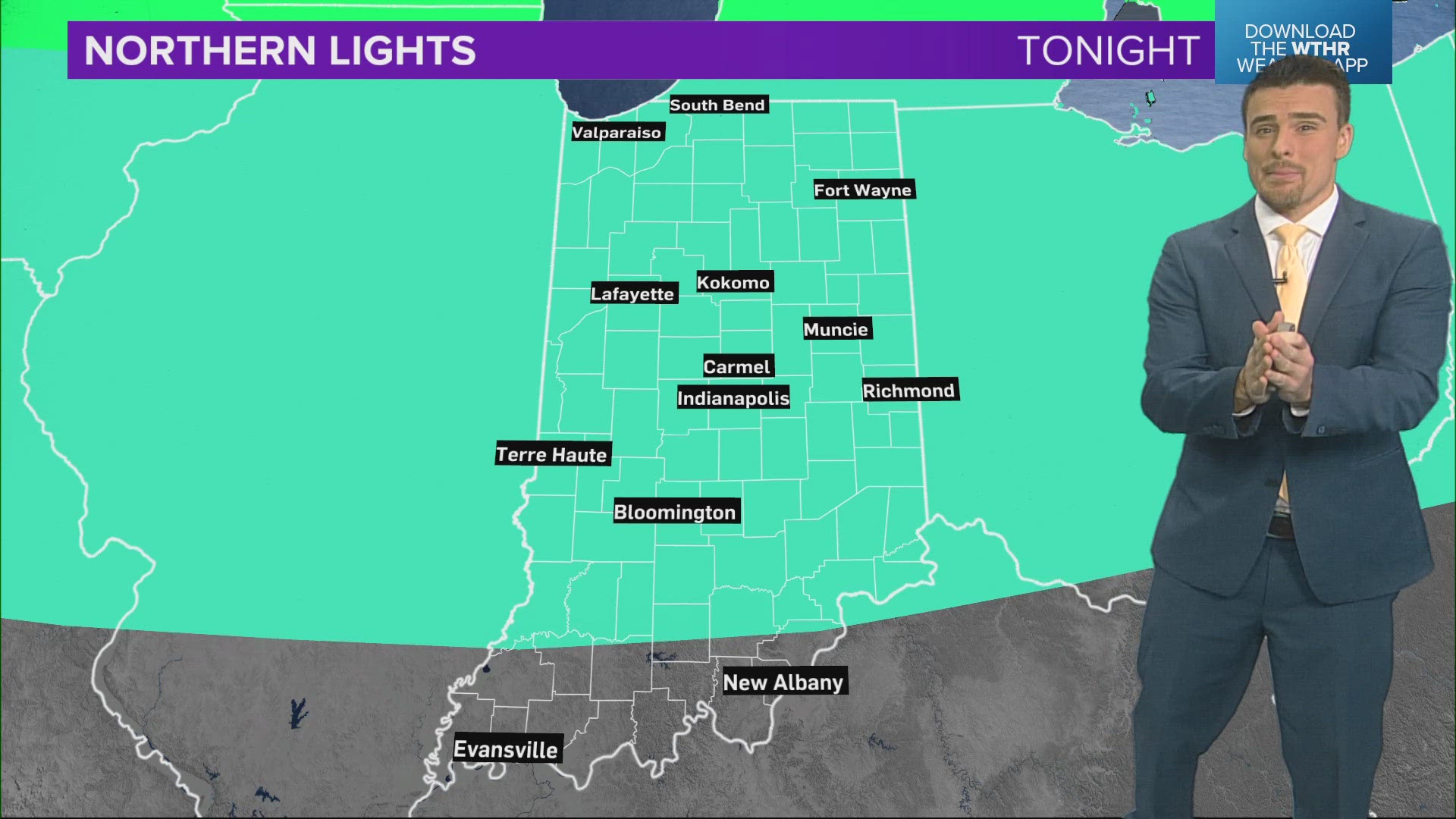INDIANA, USA — UPDATE: For an update on Thursday night and Friday morning's display of northern lights (Oct 10-11), tap HERE. A G4 storm is possible, which brings at least a chance of seeing the aurora across all of Indiana, but especially the northern half.
Can we see the northern lights from Indiana? Possibly. But it's not a guarantee with a G3 (out of G5 storm) warning.
The biggest solar flare since 2017 erupted from the surface of the sun earlier this week and the solar storm is starting to impact earth, creating a the northern lights. But how far south they can be seen is the next questions.
Tap HERE to track how clear the skies will be where you live with our interactive satellite and radar.
You may see very aggressive aurora forecasts online, but here is the point that is missed. Just because it is the biggest flare, doesn't mean it hits Earth perfectly to bring the biggest northern lights display.
If you want to see them, you have to use a camera. The longer your exposure, the greater the chance your camera will be able to pick up the northern lights.
RELATED ACROSS THE USA: Where you may be able to see the northern lights this weekend
How far south may we see the northern lights?
The bright green color shows areas where northern lights will be likely Saturday night. The light teal color shows areas where you may be able to see the northern lights in the northern sky with a camera.
States like Michigan, Wisconsin, Minnesota, and the Dakotas should be in great shape to see some northern lights. States like Indiana, Illinois, and Ohio are more in a questionable zone. It is possible, but you will have to have a camera and you have to get away from city lights.
One piece of extra good news! The moon will set before 9 p.m., helping the skies to be extra dark.


Indiana northern lights forecast
This is a closer look at the map for Indiana.
Most of the state north, except for areas near the Ohio River in southwestern Indiana, has at least a small or medium chance to see some northern lights tonight. They will most likely be in the northern horizon, rather than directly above us.


If you want to have a better chance of seeing the lights, head to southern Michigan. However, do not go too far north. There may be some extra clouds in northern Michigan, which would block your view.
Geomagnetic storm scale
Every solar storm is different, but we want to recap what we have seen so far this year to help predict was is possible tonight.
- G1 storm: northern lights NOT VISIBLE in Indiana
- G2 storm: northern lights NOT VISIBLE in Indiana
- G3 storm: northern lights MAY BE SEEN BRIEFLY at times in Indiana, especially in northern Indiana
- G4 storm: northern lights ARE VISIBLE, generally north of I-70
- G5 storm: northern lights ARE VISIBLE, all over Indiana
We are at a strong G3 storm level. While the northern lights may be possibly seen in Indiana, it is not a guarantee. The best chance to see them will be to drive north.
As we get closer to the overnight hours, the G-level may be upgraded or downgraded.
(NOTE: There was a northern lights possibility last night but there were not many reports of seeing them across the Midwest. It didn't register as strong on our satellites either. Tonight's chance is stronger, however.)
When can I see the lights?
Any night time hours will be fair game, but the best chance to see them will likely be from 9 p.m. to 4 a.m. Saturday night into Sunday morning.
We track something called Kp, which is the planetary K index, which measures the level of geomagnetic activity.
We are expecting a 7 tonight (scale from 0 to 9).
8 p.m. to 10 p.m.: Kp 7
10 p.m. to Midnight: Kp 7
Midnight to 2 a.m.: Kp 7
2 a.m. to 5 a.m.: Kp 6 (starts to decrease again)
We would probably suggest looking up and to the northern sky Saturday night around 10 p.m. to midnight.
Tips for seeing the northern lights (especially for weaker solar storms)
- Get far away from city lights
- Look north
- Use a camera — set for long exposure
- Bring patience. The northern lights are not constant. They move and flow and the intensity of how well you can see them is constantly changing
- Just know that seeing the northern lights is not a guarantee.
Simple way to explain how northern lights forecasts work
We watch the sun and the consequential solar wind that emits from the sun. We analyze sunspots and watch for CMEs or solar eruptions and flares that could launch geomagnetic storms toward Earth that activate the northern lights.
Once we are tracking a flare or eruption, we usually have 1-3 days before we get the maximum impact. At this time we give out northern lights and radio/GPS impact forecasts.
Once the solar storm approaches, our satellites start to analyze the actual strength of the storm and how it is impacting our magnetosphere. Sometimes the impact is greater than we thought, or weaker than we thought. We adjust our forecasts from there.
Sometimes we just have to wait and see what the night sky brings. Northern lights forecasting is not 100% accurate.

